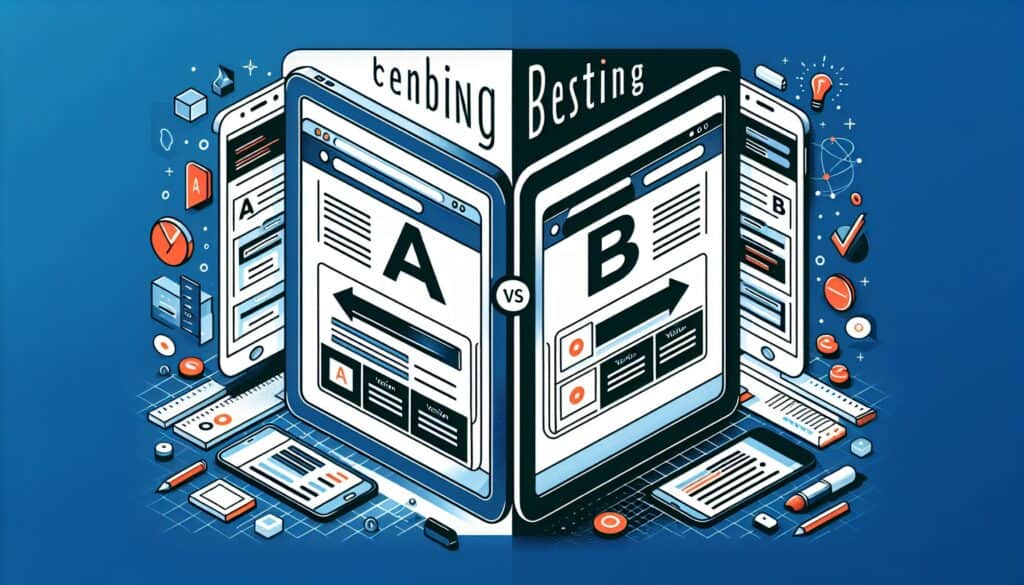Méthode de comparaison de deux versions d'une page web, d'un écran d'application, d'un courriel ou autre commercialisation (version A et version B) afin de déterminer laquelle est la plus performante pour atteindre un objectif spécifique (par exemple, un taux de conversion plus élevé, un plus grand nombre de clics).
- Méthodologies : Ergonomie
Tests A/B

Tests A/B
- Tests A/B, Amélioration continue, Taux de conversion, Marketing numérique, Développement itératif, Statistical Analysis, Méthodes d'essai, Expérience utilisateur (UX), Interface utilisateur (UI)
Objectif :
Comment il est utilisé :
- Les utilisateurs se voient présenter au hasard la version A ou la version B. Leurs interactions sont suivies et une analyse statistique est utilisée pour déterminer s'il existe une différence significative de performance entre les deux versions pour une mesure donnée.
Avantages
- Elle fournit des données sur ce qui fonctionne le mieux pour les utilisateurs ; elle permet des améliorations itératives basées sur des preuves plutôt que sur l'intuition ; elle peut conduire à des améliorations significatives des indicateurs clés.
Inconvénients
- Nécessite un trafic/des utilisateurs suffisants pour obtenir des résultats statistiquement significatifs ; Tester trop de variables à la fois peut être déroutant ; Des facteurs externes peuvent parfois influencer les résultats ; Se concentre sur des changements progressifs, peut ne pas conduire à une innovation radicale.
Catégories :
- Clients et marketing, Économie, Conception de Produits
Idéal pour :
- Optimiser les pages web, les interfaces d'applications, les campagnes d'emailing et autres expériences digitales pour améliorer l'engagement des utilisateurs et les taux de conversion.
Les tests A/B sont largement utilisés dans divers secteurs, en particulier dans le marketing numérique, le commerce électronique et le développement de logiciels, où les entreprises cherchent à améliorer l'expérience des utilisateurs et à obtenir des taux de conversion plus élevés. Dans le domaine de la conception de sites web, cette méthodologie est souvent employée au cours des premières étapes du développement de l'interface utilisateur, ce qui permet aux concepteurs et aux développeurs de comprendre les préférences des utilisateurs en temps réel. Les spécialistes du marketing utilisent fréquemment les tests A/B dans les campagnes de courrier électronique pour affiner les lignes d'objet, le contenu ou les boutons d'appel à l'action, ce qui leur permet d'identifier les éléments qui trouvent le plus d'écho auprès de leur public. Son utilité s'étend au développement d'applications mobiles, où il permet d'évaluer différentes mises en page ou fonctionnalités avant le lancement. Les participants aux tests A/B sont généralement des chefs de produit, des concepteurs UX, des analystes de données et des développeurs, qui collaborent tous à la conception des expériences, à la définition des mesures de performance et à l'analyse des résultats. Les mises en œuvre réussies s'appuient sur des hypothèses prédéfinies et des groupes de test bien structurés pour garantir la validité statistique. Au fur et à mesure que les entreprises accumulent des données grâce à des tests itératifs, elles peuvent prendre des décisions éclairées qui conduisent à une meilleure satisfaction de la clientèle, à des taux de fidélisation plus élevés et à une augmentation du chiffre d'affaires, établissant ainsi une boucle de rétroaction solide qui affine continuellement les offres de produits en se basant sur des preuves empiriques plutôt que sur des suppositions. En outre, les tests A/B peuvent être adaptés à différents contextes de projet, qu'il s'agisse de lancer de nouveaux produits, d'optimiser des fonctionnalités existantes ou d'explorer des stratégies de marketing, ce qui offre aux entreprises la flexibilité nécessaire pour évoluer en fonction des besoins et des préférences des utilisateurs tout en atténuant les risques associés aux changements majeurs.
Principales étapes de cette méthodologie
- Définir l'hypothèse et identifier les indicateurs clés de performance (ICP) à mesurer.
- Élaborer une version A (contrôle) et une version B (variante) avec des différences distinctes à tester.
- Assigner aléatoirement les utilisateurs à chaque version à l'aide de l'allocation aléatoire.
- Mettre en place des mécanismes de suivi pour contrôler les interactions des utilisateurs et les paramètres pertinents.
- Réaliser l'expérience pendant une durée prédéterminée afin de garantir la validité statistique.
- Appliquer des méthodes d'analyse statistique pour comparer les performances des deux versions.
- Déterminer si les résultats indiquent une différence statistiquement significative.
- Prendre des décisions éclairées sur la base des résultats de l'analyse en vue d'améliorations itératives.
Conseils de pro
- Segmentez les utilisateurs en fonction de leur comportement et de leurs données démographiques pour réaliser des tests A/B ciblés, afin d'améliorer la pertinence et la précision des résultats.
- Effectuer des tests multivariés parallèlement aux tests A/B afin d'identifier les interactions entre plusieurs variables, ce qui permet d'obtenir des informations plus approfondies.
- Mettre en place un système de suivi robuste qui enregistre les parcours des utilisateurs et les points d'abandon, ce qui permet une analyse complète des résultats des tests.
Lire et comparer plusieurs méthodologies, nous recommandons le
> Référentiel méthodologique étendu <
ainsi que plus de 400 autres méthodologies.
Vos commentaires sur cette méthodologie ou des informations supplémentaires sont les bienvenus sur le site web de la Commission européenne. section des commentaires ci-dessous ↓ , ainsi que toute idée ou lien en rapport avec l'ingénierie.
Contexte historique
1960
1980
1983
1990
1995
2000
2010
1950
1980
1980
1986
1994
1995
2000
(si la date est inconnue ou n'est pas pertinente, par exemple "mécanique des fluides", une estimation arrondie de son émergence notable est fournie)














Articles Similaires
Calculateur de METS en calories
Méta-analyse
Cartographie des messages
Diagrammes du modèle mental
Forces de poussée et de traction maximales acceptables
Planification des besoins en matériaux (MRP)